5.4. Analysis of DOE data
5.4.7. Examples of DOE's
5.4.7.1. |
Full factorial example |
The original data set was part of a high performance ceramics experiment with the goal of characterizing the effect of grinding parameters on sintered reaction-bonded silicon nitride, reaction bonded silicone nitride, and sintered silicon nitride.
Only modified data from the first of the three ceramic types (sintered reaction-bonded silicon nitride) will be discussed in this illustrative example of a full factorial data analysis.
The reader can download the data as a text file.
Response variable = mean (over 15 repetitions) of the ceramic strength
Number of observations = 32 (a complete 25 factorial design)
-
Response Variable Y = Mean (over 15 reps) of Ceramic Strength
Factor 1 = Table Speed (2 levels: slow (.025 m/s) and fast (.125 m/s))
Factor 2 = Down Feed Rate (2 levels: slow (.05 mm) and fast (.125 mm))
Factor 3 = Wheel Grit (2 levels: 140/170 and 80/100)
Factor 4 = Direction (2 levels: longitudinal and transverse)
Factor 5 = Batch (2 levels: 1 and 2)
speed rate grit direction batch strength order
1 -1 -1 -1 -1 -1 680.45 17
2 1 -1 -1 -1 -1 722.48 30
3 -1 1 -1 -1 -1 702.14 14
4 1 1 -1 -1 -1 666.93 8
5 -1 -1 1 -1 -1 703.67 32
6 1 -1 1 -1 -1 642.14 20
7 -1 1 1 -1 -1 692.98 26
8 1 1 1 -1 -1 669.26 24
9 -1 -1 -1 1 -1 491.58 10
10 1 -1 -1 1 -1 475.52 16
11 -1 1 -1 1 -1 478.76 27
12 1 1 -1 1 -1 568.23 18
13 -1 -1 1 1 -1 444.72 3
14 1 -1 1 1 -1 410.37 19
15 -1 1 1 1 -1 428.51 31
16 1 1 1 1 -1 491.47 15
17 -1 -1 -1 -1 1 607.34 12
18 1 -1 -1 -1 1 620.80 1
19 -1 1 -1 -1 1 610.55 4
20 1 1 -1 -1 1 638.04 23
21 -1 -1 1 -1 1 585.19 2
22 1 -1 1 -1 1 586.17 28
23 -1 1 1 -1 1 601.67 11
24 1 1 1 -1 1 608.31 9
25 -1 -1 -1 1 1 442.90 25
26 1 -1 -1 1 1 434.41 21
27 -1 1 -1 1 1 417.66 6
28 1 1 -1 1 1 510.84 7
29 -1 -1 1 1 1 392.11 5
30 1 -1 1 1 1 343.22 13
31 -1 1 1 1 1 385.52 22
32 1 1 1 1 1 446.73 29
First, we look at the distribution of the response variable regardless of factor levels by generating the following four plots.
- The first plot is a normal probability plot of the response variable. The red line is the theoretical normal distribution.
- The second plot is a box plot of the response variable.
- The third plot is a histogram of the response variable.
- The fourth plot is the response versus the run order.
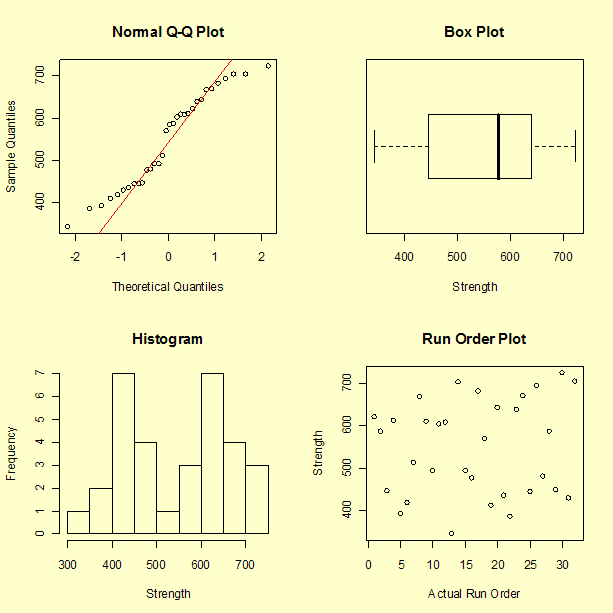
Clearly there is "structure" that we hope to account for when we fit a response model. For example, the response variable is separated into two roughly equal-sized clumps in the histogram. The first clump is centered approximately around the value 450 while the second clump is centered approximately around the value 650. As hoped for, the run-order plot does not indicate a significant time effect.
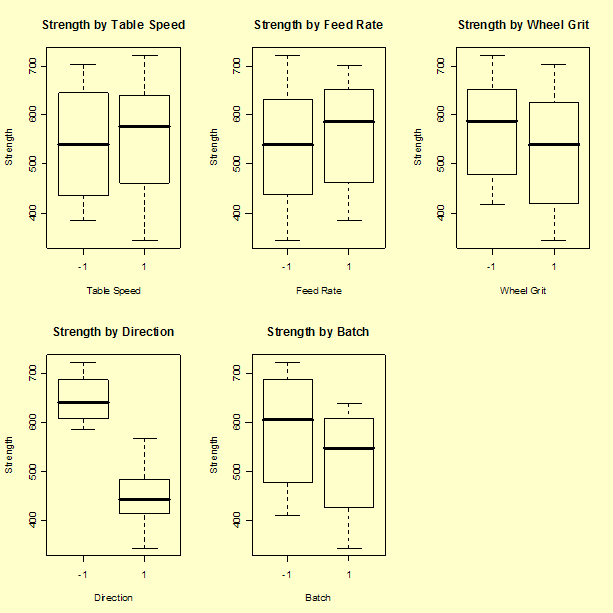
Several factors, most notably "Direction" followed by "Batch" and possibly "Wheel Grit", appear to change the average response level.
Summary of Fit
RSquare 0.995127
RSquare Adj 0.974821
Root Mean Square Error 17.81632
Mean of Response 546.8959
Observations 32
Sum
Source DF of Squares F Ratio Prob>F
X1: Table Speed 1 894.33 2.8175 0.1442
X2: Feed Rate 1 3497.20 11.0175 0.0160
X1: Table Speed* 1 4872.57 15.3505 0.0078
X2: Feed Rate
X3: Wheel Grit 1 12663.96 39.8964 0.0007
X1: Table Speed* 1 1838.76 5.7928 0.0528
X3: Wheel Grit
X2: Feed Rate* 1 307.46 0.9686 0.3630
X3: Wheel Grit
X1:Table Speed* 1 357.05 1.1248 0.3297
X2: Feed Rate*
X3: Wheel Grit
X4: Direction 1 315132.65 992.7901 <.0001
X1: Table Speed* 1 1637.21 5.1578 0.0636
X4: Direction
X2: Feed Rate* 1 1972.71 6.2148 0.0470
X4: Direction
X1: Table Speed 1 5895.62 18.5735 0.0050
X2: Feed Rate*
X4: Direction
X3: Wheel Grit* 1 3158.34 9.9500 0.0197
X4: Direction
X1: Table Speed* 1 2.12 0.0067 0.9376
X3: Wheel Grit*
X4: Direction
X2: Feed Rate* 1 44.49 0.1401 0.7210
X3: Wheel Grit*
X4: Direction
X5: Batch 1 33653.91 106.0229 <.0001
X1: Table Speed* 1 465.05 1.4651 0.2716
X5: Batch
X2: Feed Rate* 1 199.15 0.6274 0.4585
X5: Batch
X1: Table Speed* 1 144.71 0.4559 0.5247
X2: Feed Rate*
X5: Batch
X3: Wheel Grit* 1 29.36 0.0925 0.7713
X5: Batch
X1: Table Speed* 1 30.36 0.0957 0.7676
X3: Wheel Grit*
X5: Batch
X2: Feed Rate* 1 25.58 0.0806 0.7860
X3: Wheel Grit*
X5: Batch
X4: Direction * 1 1328.83 4.1863 0.0867
X5: Batch
X1: Table Speed* 1 544.58 1.7156 0.2382
X4: Directio*
X5: Batch
X2: Feed Rate* 1 167.31 0.5271 0.4952
X4: Direction*
X5: Batch
X3: Wheel Grit* 1 32.46 0.1023 0.7600
X4: Direction*
X5: Batch
Summary of Fit
RSquare 0.989114
RSquare Adj 0.982239
Root Mean Square Error 14.96346
Mean of Response 546.8959
Observations (or Sum Wgts) 32
Sum
Source DF of Squares F Ratio Prob>F
X1: Table Speed 1 894.33 3.9942 0.0602
X2: Feed Rate 1 3497.20 15.6191 0.0009
X1: Table Speed* 1 4872.57 21.7618 0.0002
X2: Feed Rate
X3: Wheel Grit 1 12663.96 56.5595 <.0001
X1: Table Speed* 1 1838.76 8.2122 0.0099
X3: Wheel Grit
X4: Direction 1 315132.65 1407.4390 <.0001
X1: Table Speed* 1 1637.21 7.3121 0.0141
X4: Direction
X2: Feed Rate* 1 1972.71 8.8105 0.0079
X4: Direction
X1: Table Speed* 1 5895.62 26.3309 <.0001
X2: Feed Rate*
X4:Direction
X3: Wheel Grit* 1 3158.34 14.1057 0.0013
X4: Direction
X5: Batch 1 33653.91 150.3044 <.0001
X4: Direction* 1 1328.83 5.9348 0.0249
X5: Batch
A normal probability plot of the effects is shown below. (To reduce the scale of the y-axis, the largest two effects, X4: Direction and X5: Batch, are not shown on the plot. In addition, these two effects were not used to compute the normal reference line.) The effects we consider to be significant are labeled. In this case, we have arrived at the exact same 12 terms by looking at the normal probability plot as we did from the stepwise regression.
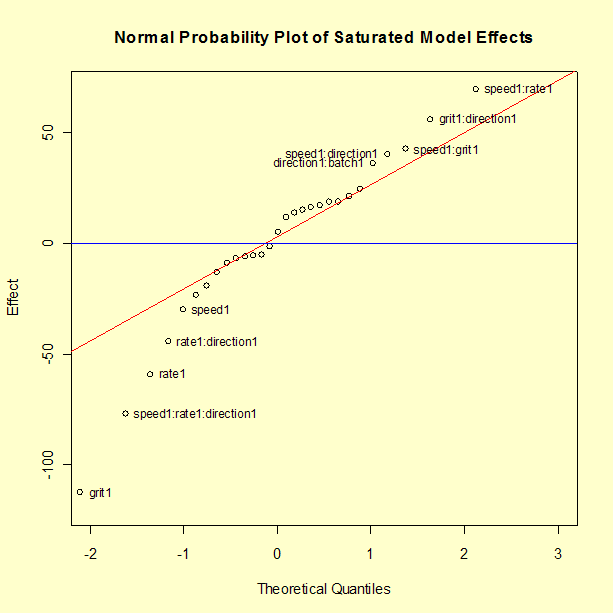
Most of the effects cluster close to the center (zero) line and follow the fitted normal model straight line. The effects that appear to be above or below the line by more than a small amount are the same effects identified using the stepwise routine, with the exception of X1. Some analysts prefer to include a main effect term when it has several significant interactions even if the main effect term itself does not appear to be significant.
However, before accepting any model, residuals need to be examined.

The residuals appear to spread out more with larger values of predicted strength, which should not happen when there is a common variance.
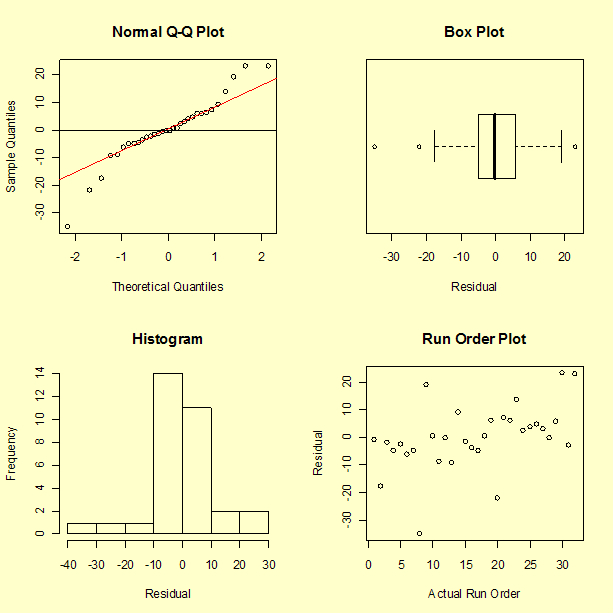
None of these plots appear to show typical normal residuals and the boxplot indicates that there may be outliers.
 that maximizes the negative log likelihood.
that maximizes the negative log likelihood.
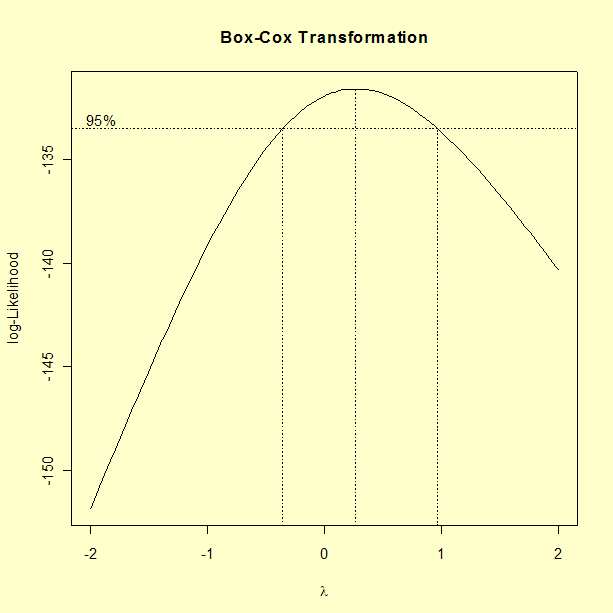
The optimum is found at
 = 0.2.
A new Y: Strength variable is calculated using:
= 0.2.
A new Y: Strength variable is calculated using:

The 11-Effect Model Fit to Tranformed Response Data
Response: Y:NewStrength
Summary of Fit
RSquare 0.99041
RSquare Adj 0.985135
Root Mean Square Error 13.81065
Mean of Response 1917.115
Observations (or Sum Wgts) 32
Parameter
Effect Estimate p-value
Intercept 1917.115 <.0001
X1: Table Speed 5.777 0.0282
X2: Feed Rate 11.691 0.0001
X1: Table Speed* -14.467 <.0001
X2: Feed Rate
X3: Wheel Grit -21.649 <.0001
X1: Table Speed* 7.339 0.007
X3: Wheel Grit
X4: Direction -99.272 <.0001
X1: Table Speed* -7.188 0.0080
X4: Direction
X2: Feed Rate* -9.160 0.0013
X4: Direction
X1: Table Speed* 15.325 <.0001
X2: Feed Rate*
X4:Direction
X3: Wheel Grit* 12.965 <.0001
X4: Direction
X5: Batch -31.871 <.0001
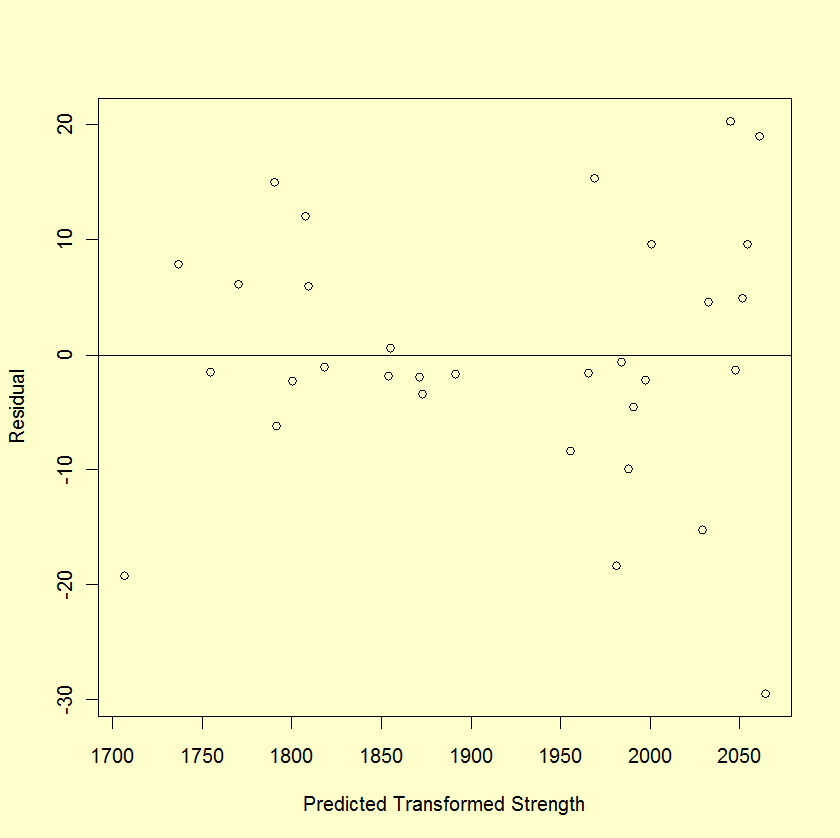
The normal probability plot, box plot, and the histogram of the residuals do not indicate any serious violations of the model assumptions. The run sequence plot of the residuals does not indicate any time dependent patterns.
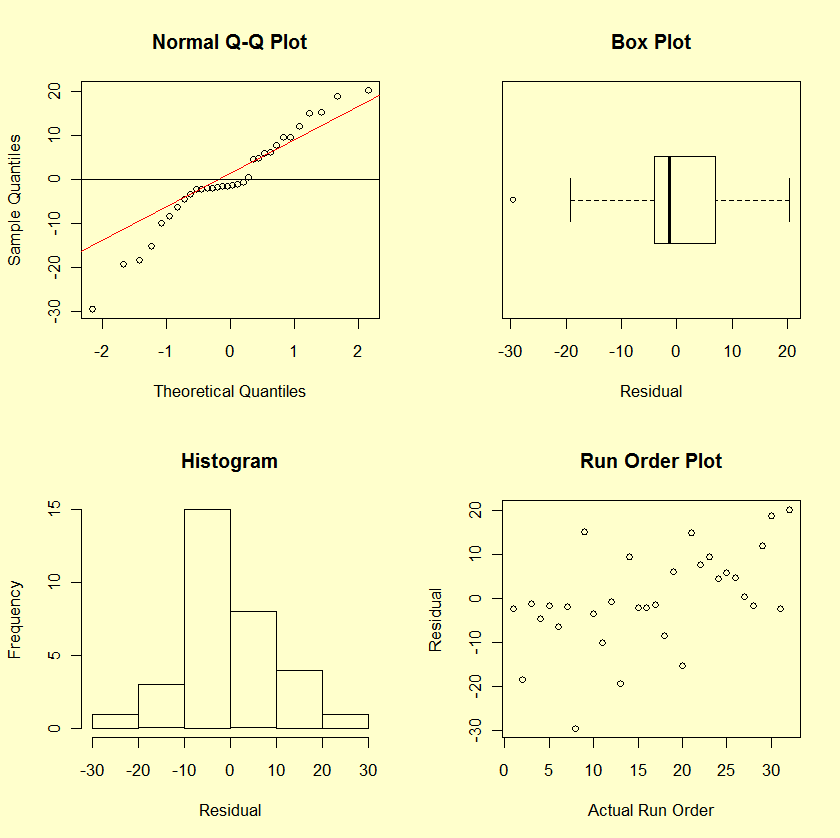
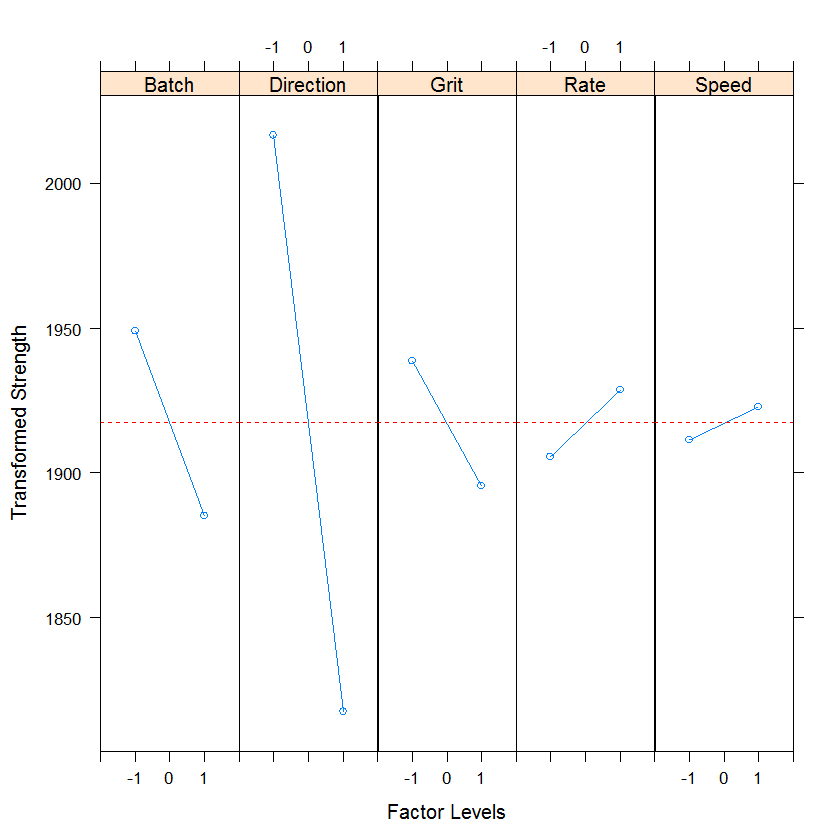

Next, we plot 2-way interaction plot showing means for all combinations of levels for the two factors.
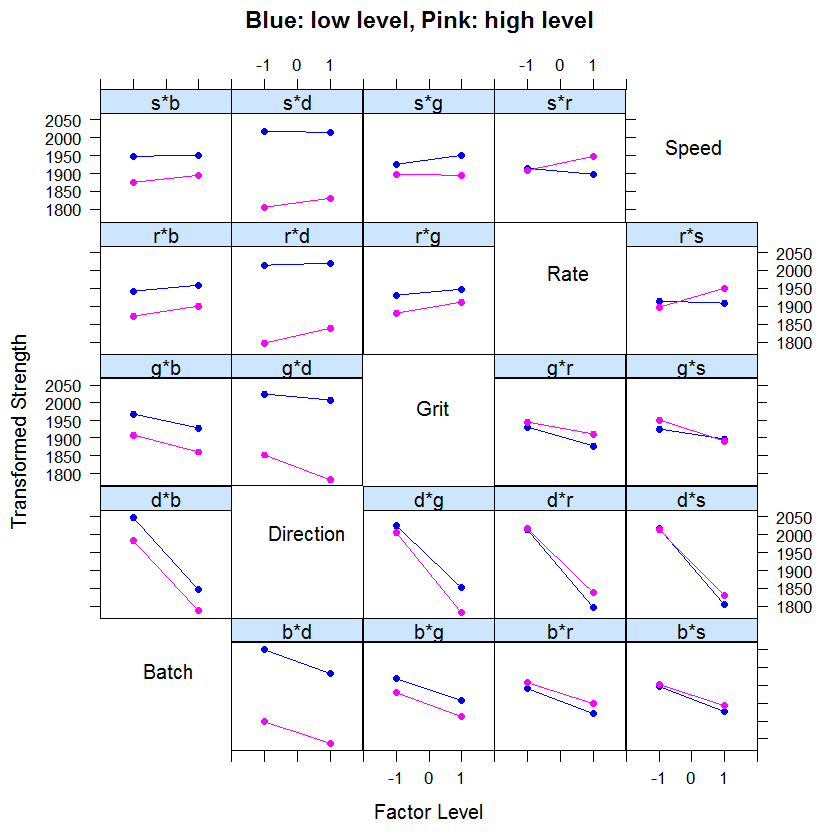
The labels located in the diagonal spaces of the plot grid have two purposes. First, the label indicates the factor associated with the x-axis for all plots in the same row. Second, the label indicates the factor defining the two lines for plots in the same column.
For example, the plot labeled r*s contains averages for low and high levels of the rate variable (x-axis) for both levels of speed. The blue line represents the low level of speed and the pink line represents the high level of speed. The two lines in the r*s plot cross, indicating that there is interaction between rate and speed. Parallel lines indicate that there is no interaction between the two factors.
Unfortunately, "Batch" is also a very significant factor, with the first batch giving higher strengths than the second. Unless it is possible to learn what worked well with this batch, and how to repeat it, not much can be done about this factor.
- One might ask what an analysis of just the 24 factorial
with "Direction" kept at -1 (i.e., longitudinal) would yield. This
analysis turns out to have a very simple model; only "Wheel Grit"
and "Batch" are significant main effects and no interactions are
significant.
If, on the other hand, we do an analysis of the 24 factorial with "Direction" kept at +1 (i.e., transverse), then we obtain a 7-parameter model with all the main effects and interactions we saw in the 25 analysis, except, of course, any terms involving "Direction".
So it appears that the complex model of the full analysis came from the physical properties of a transverse cut, and these complexities are not present for longitudinal cuts.
- If we had assumed that three-factor and higher interactions were negligible before experimenting, a \( 2_{V}^{5-1} \) half fraction design might have been chosen. In hindsight, we would have obtained valid estimates for all main effects and two-factor interactions except for X3 and X5, which would have been aliased with X1*X2*X4 in that half fraction.
- Finally, we note that many analysts might prefer to adopt a natural logarithm transformation (i.e., use ln Y) as the response instead of using a Box-Cox transformation with an exponent of 0.2. The natural logarithm transformation corresponds to an exponent of \( \lambda \)= 0 in the Box-Cox graph.

